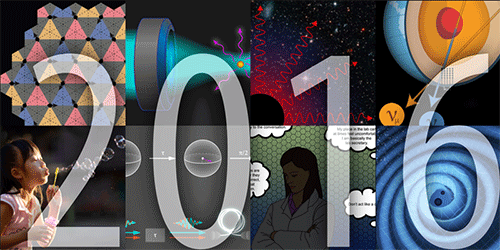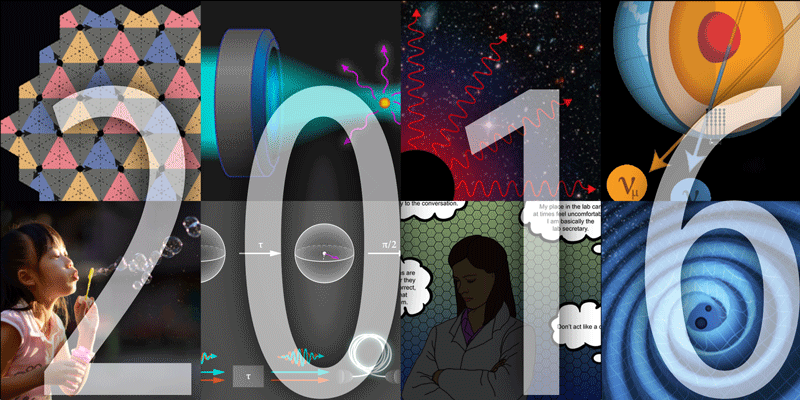Highlights of the Year
It’s no surprise that LIGO’s discovery of gravitational waves tops our list of favorite Physics stories in 2016. The other slots went to research that marked a change in perspective, demonstrated an impressive experimental feat, or simply made us think.
Wishing everyone a happy start to 2017.
–The Editors
LIGO Detects Gravitational Waves
Hands down, the biggest physics story of the year was LIGO’s detection of gravitational waves from merging black holes: the observation of one set of waves was announced in February (see Viewpoint: The First Sounds of Merging Black Holes), and another set was revealed in June (see Focus: LIGO Bags Another Black Hole). Had this “just” been the first direct detection of the ripples in spacetime that Einstein predicted a century ago, it would have been an incredible result. But what made it soar was the fact that it was also the first observational evidence that pairs of black holes can form and merge in the cosmos. If that wasn’t enough, the findings also mark the dawn of a new era in gravitational-wave astronomy, one in which ground-based gravitational-wave detections will become commonplace and will be combined with other astronomical observations. These include data obtained at optical, radio, and other wavelengths, as well as future space-based gravitational-wave observations (see Viewpoint: Paving the Way to Space-Based Gravitational-Wave Detectors).
Gender Stereotyping in Physics Labs
Men dominate physics, as a glance into almost any physics department would show. For those women who do pursue physics research, the work environment can be rife with subtle and overt gender stereotypes, according to two teams of social scientists who delved into the culture of physics labs (see Viewpoint: How Stereotypes Impact Women in Physics). In interviews conducted with students and faculty members at physics departments in the US, Canada, and Western Europe, the researchers recorded the use of sexist jokes and derogatory language, such as “don’t act like a chick.” They also found that female students often had their ideas ignored and their successes undermined. This ultimately eroded their sense of belonging—a factor that can influence whether women stay in the field. Writing about the results, social psychologist Nilanjana Dasgupta recommended that physics departments tackle the issue by seeking training and calling out sexist behavior when they see it.
Hawking Says Black Holes Have “Soft Hair”
Forty years ago, Stephen Hawking argued that black holes evaporate, thereby destroying all of the information they contain. The proposal flew in the face of quantum mechanics, which says information is always preserved, and sparked a fierce controversy known as the black hole information paradox. This year, Hawking weighed in again on the debate. Working with his colleague Malcolm Perry at the University of Cambridge, and Andrew Strominger of Harvard University, he showed that an assumption that led to the paradox might be wrong. The assumption is that the information inside a black hole is invisible from its exterior—a tenet often summarized by saying “black holes have no hair.” Instead, the trio posited that black holes carry “soft” hair—low-energy quantum excitations that could release some of the black hole’s information (see Viewpoint: Black Holes Have Soft Quantum Hair). Their calculations don’t yet resolve the paradox, but they may point researchers towards a path to doing so.
Photon Wind Buffets Nanosphere
Sensitive force detectors can use optically levitated nanosized objects as test masses that jiggle in response to external forces. With one such device, a team from the Swiss Federal Institute of Technology (ETH) managed to detect the jiggles of a nanosphere caused by photons ricocheting off its surface (see Viewpoint: Measuring Quantum Kicks from a Beam of Light). The feat is impressive when you consider that the kick from a single photon is ten billion times smaller than the minimum oscillation energy of the sphere in its optical trap. Many photons are needed, therefore, to budge the object, but absorption of some of these photons causes thermal noise that has masked the signal from photon recoil in previous studies. To minimize thermal noise, the researchers performed their experiments in high vacuum and cooled their nanosphere to a few hundred microkelvins. By demonstrating that the sphere’s motion was dominated by photon recoil, they made an important step towards studying quantum mechanics at the macroscopic level.
Trouble for Sterile Neutrinos
In a blow to theories that predict a fourth type of neutrino, the IceCube Collaboration reported that it had significantly narrowed down the range of masses that such particles could possibly have (see Viewpoint: Hunting the Sterile Neutrino). Neutrinos come in three flavors: electron, muon, and tau. Recently, however, researchers had hoped that discovering an additional “sterile” neutrino, which interacts only through gravity and isn’t in the standard model, would be the next big thing in physics. Hints for the particles had been seen in experiments, though never confirmed. IceCube, a giant observatory at the South Pole, searched for sterile neutrinos by monitoring the disappearance of muon neutrinos and antineutrinos passing through Earth’s core. Assuming the sterile neutrino is heavier than the other neutrinos, a roughly 100% disappearance of muon antineutrinos was expected. But IceCube observed no such disappearance. On the positive side, upcoming searches for the hypothetical particles now have a much better idea of where to look.
Crystal’s Symmetry Lies in How it Moves
Crystals are known for their beautiful spatial symmetry, but some crystals can also have time symmetry, according to three theorists from Canada’s Perimeter Institute (see Focus: New Crystal Type is Always in Motion). They began by imagining a set of four satellites orbiting the Sun, with the orbits timed so that the view from each would be identical. The most symmetrical arrangement has the satellites appearing at the corners of a square six times per orbit but never crossing the same point simultaneously (see video in Focus story). The team then generalized this motion to satellites and went on to propose the concept of “choreographic symmetry,” a time symmetry analogous to crystalline symmetry in space. The researchers described a range of such crystals in two or more dimensions and suggested that these configurations might appear in the motions of electrons or atomic nuclei.
Color Duality in Photons
Photons sometimes behave like waves, sometimes like particles. But one thing that has always seemed fixed about their identity was their color, or frequency. Disappointing that expectation, researchers from Cornell University generated single photons that are a superposition of two distinct colors (see Viewpoint: Photon Qubit is Made of Two Colors). A frequency detector analyzing this “bichromatic” light would measure color A half the time and color B the other half. However, the two colors are not merely mixed. Rather, each photon has a split color identity, which the researchers revealed by sending single photons through an interferometer and observing interference fringes. These photons might encode quantum information in the two frequency states, similar to how distinct polarization states are currently used to carry information. Such two-color photon qubits could entangle two memory devices operating in different frequency ranges.
Physicists Perfect the Art of Bubble Blowing
Apropos for a year-end list, here’s a toast to something bubbly. Inspired by children at the playground, researchers from the CNRS and the University of Rennes I in France reported how they set out to understand the physics behind bubble blowing (see Focus: Physics of Blowing Bubbles). The scientists built a bubble-blowing machine that let them control the speed of a gas jet striking a meter-high soap film—the equivalent of a giant bubble wand. As lay bubble-blowers might have guessed, bubbles only form above a threshold jet speed, and they develop at lower speeds for wider jets. But the group also found that the film’s thickness doesn’t matter. Their apparatus might be useful for classroom demonstrations of the physics of bubbles, which appear in suds and even in models of cosmology. For us, the French team’s experiment is simply a lovely tale of physics research being influenced by everyday surroundings.





